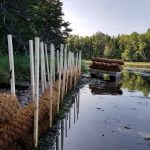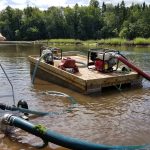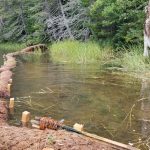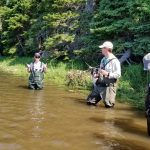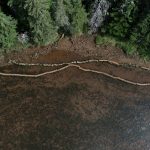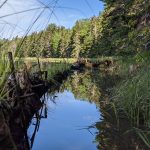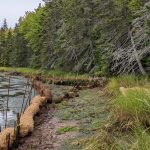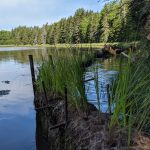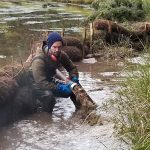Project Description
The Coastal Restoration Fund provides money to projects addressing threats to marine habitats and species along Canada’s coasts. Rehabilitation to aquatic habitats, contributing to long-term sustainability, and encouraging, engaging and consulting both community and Indigenous groups are core principles of projects funded by the Coastal Restoration Fund.
Souris Wildlife used this funding for a Living Shorelines pilot project to restore salt marsh in Souris River from 2018 to 2021. The project involved trialling three different methods of Living Shoreline materials to see what works best in PEI estuaries. The three materials used were:
- Coir fibre logs – 12ft logs made from recycled coconut husks are layered up to form a retaining wall, secured in place with stakes and twine
- Brush matting – boughs of nearby coniferous trees are cut down and secured in place using stakes and twine
- Jute bags and oyster shells – jute bags are filled with old oyster shells and layered up to form a retaining wall.
The areas in and behind the living shoreline materials naturally accumulated sediment through the tide flooding water and sediment over the top of them, but only the water being able to drain back out again as the tide receded. This process was augmented through the use of the sediment pump created by Souris Wildlife, which took the excess sediment from the main channel and pumped it behind the materials.
It was established after the two years that the best method and material was the use of the coir fibre logs as the brush matting did not effectively hold the sediment in place and the jute bags degraded within a few months, allowing the oyster shells to spill out therefore not forming an effective wall. The coir logs held their form well for the first couple of years but did start to disintegrate after about year three. However, this is a good time frame for allowing the marsh and native vegetation to establish behind the logs to create a new salt marsh area.
Native cordgrass, Spartina alterniflora, was transplanted into the newly established muddy areas to hold the sediment in place and form the newly restored marsh areas. The coir logs were also planted up with cordgrass plugs, making them more secure as the plants grew their roots down into the logs which helped anchor them in place.
Overall, the project was a success and Souris Wildlife will work further on using coir logs as a Living Shoreline solution to coastal erosion.

Project Funder
The Coastal Restoration Fund provides money to projects addressing threats to marine habitats and species along Canada’s coasts.


